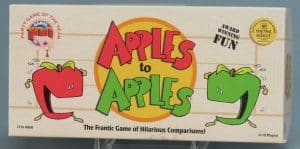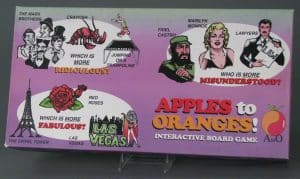 Other than Santa’s workshop at the North Pole, where do games come from? Often they start out as prototypes, initial versions that allow game inventors to test their concepts and designs. Like the first draft of a novel or the rough cut of a movie, these prototype games help illustrate the revisions and refinements that lead to a finished product, one that might go on to become a holiday season sales sensation or your family’s favorite game. But prototypes aren’t easy to come by. Some get discarded as the inventor makes improvements. Others go to toy companies as part of the “pitch” that an inventor makes to sell a concept and seal a licensing deal. So it takes effort for The Strong to add prototypes to the behind-the-scenes information it collects about the design, manufacturing, and marketing of games and toys. The Strong’s curators attend national toy, game, and electronic game expositions where they meet with toy and game inventors, designers, manufacturers, and toy industry movers and shakers. The Strong values these relationships and appreciates the many ways these individuals share their knowledge, expertise, and donations.
Other than Santa’s workshop at the North Pole, where do games come from? Often they start out as prototypes, initial versions that allow game inventors to test their concepts and designs. Like the first draft of a novel or the rough cut of a movie, these prototype games help illustrate the revisions and refinements that lead to a finished product, one that might go on to become a holiday season sales sensation or your family’s favorite game. But prototypes aren’t easy to come by. Some get discarded as the inventor makes improvements. Others go to toy companies as part of the “pitch” that an inventor makes to sell a concept and seal a licensing deal. So it takes effort for The Strong to add prototypes to the behind-the-scenes information it collects about the design, manufacturing, and marketing of games and toys. The Strong’s curators attend national toy, game, and electronic game expositions where they meet with toy and game inventors, designers, manufacturers, and toy industry movers and shakers. The Strong values these relationships and appreciates the many ways these individuals share their knowledge, expertise, and donations.
Thanks to these relationships, The Strong now holds more than 500 board and card game prototypes in its collections. Many of these are the unpublished designs of Sid Sackson (1920–2002), a legend in the game industry and best known for his bookshelf game Acquire. Sackson’s family donated hundreds of game prototypes as well as many of his personal files and diaries. Besides the works of Sackson, The Strong holds game and toy prototypes from Victor Reiling, known for designing the Fisher-Price Happy Houseboat; Ron Dubren and Greg Hyman, the collaborators on Sesame Street’s Tickle Me Elmo; Jack Degnan, creator of the award-winning game Word on the Street; Peggy Brown, whose many creative toy and games include Backseat Drawing and Hide and Eek!; and others.
 Pictured here is one of my favorite games—the award-winning 1999 Apples to Apples. Besides winning a Mensa Select game of the year award, it also garnered awards from Games magazine and the National Parenting Center. But before it was one of the hottest new games around, it was designer Matt Kirby’s prototype Apples to Oranges. Kirby submitted his game idea to the Game Keeper game design contest and Out-of-the-Box publishers. The experts at Out-of-the-Box simplified Kirby’s design and produced the game we know today, which is now being sold by Mattel. Keith Meyers of Game Keeper later donated Kirby’s prototype to The Strong with Kirby’s approval. Prototypes such as this provide glimpses of game inventors’ original creative processes. And The Strong is grateful to all these game and toy creators for helping expand and enhance the museum’s collections in such meaningful and important ways.
Pictured here is one of my favorite games—the award-winning 1999 Apples to Apples. Besides winning a Mensa Select game of the year award, it also garnered awards from Games magazine and the National Parenting Center. But before it was one of the hottest new games around, it was designer Matt Kirby’s prototype Apples to Oranges. Kirby submitted his game idea to the Game Keeper game design contest and Out-of-the-Box publishers. The experts at Out-of-the-Box simplified Kirby’s design and produced the game we know today, which is now being sold by Mattel. Keith Meyers of Game Keeper later donated Kirby’s prototype to The Strong with Kirby’s approval. Prototypes such as this provide glimpses of game inventors’ original creative processes. And The Strong is grateful to all these game and toy creators for helping expand and enhance the museum’s collections in such meaningful and important ways.



